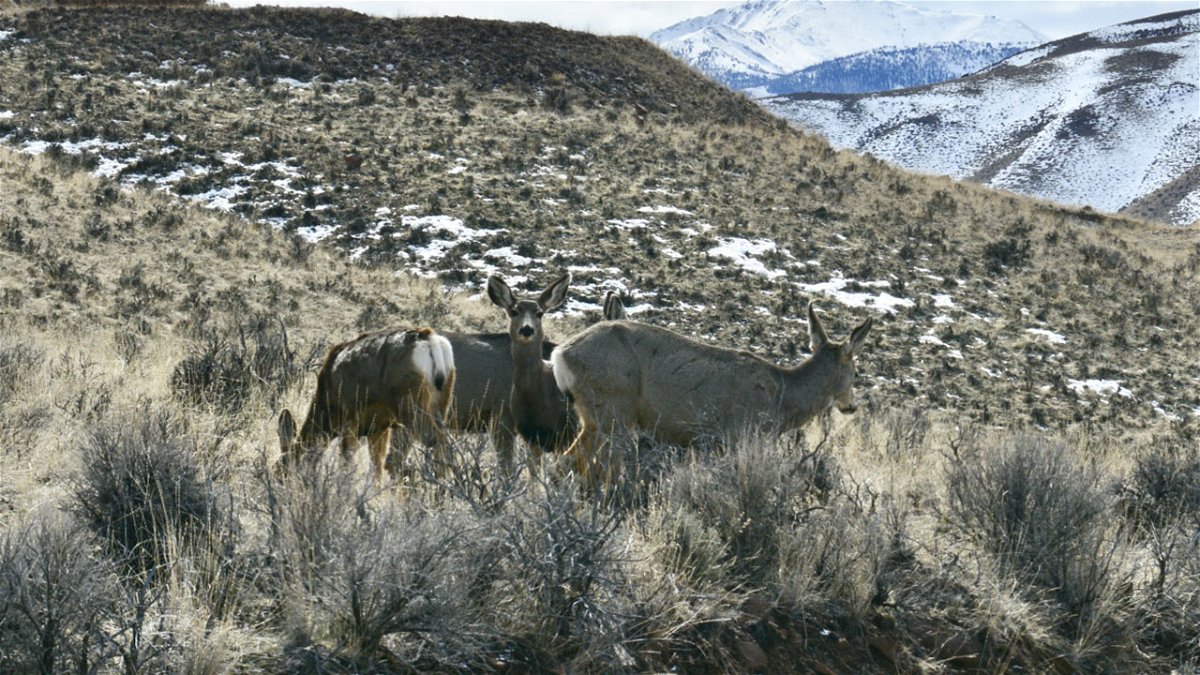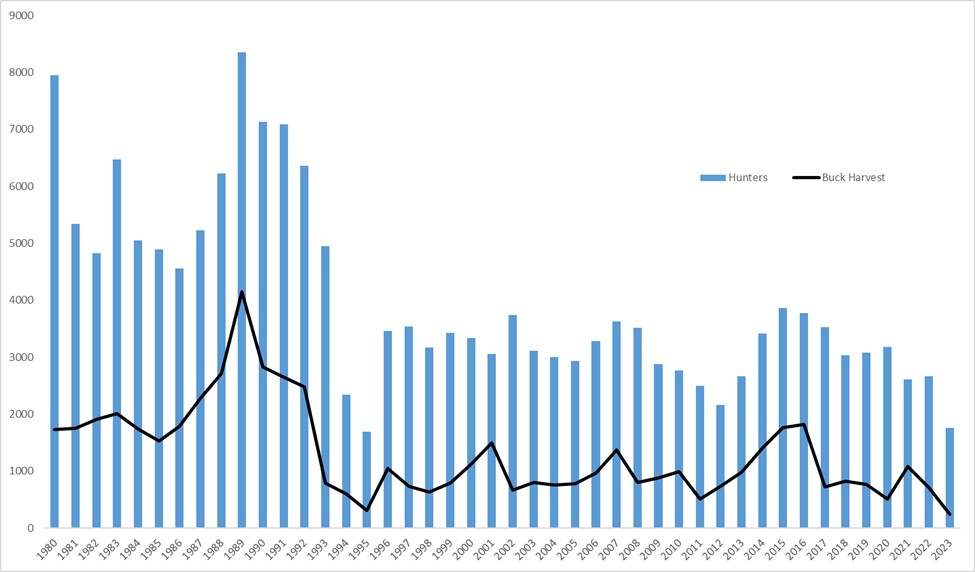Harsh winters mean harsh truths for southeast Idaho mule deer

IDAHO FALLS, Idaho (KIFI) - Winter is an extremely stressful time of year for mule deer in southeastern Idaho and is the single largest factor shaping deer numbers on the landscape from year-to-year.
Freezing temperatures and snowfall dramatically reduce the amount and quality of available forage, deer function at a caloric deficit for several months, and large-scale die-offs (from starvation and exposure) can occur. Fawns approximately 6 months old at the beginning of winter are the first to die, followed by older and sickly individuals, and lastly, healthy adults during the most severe winters. Even during “normal” winters about 40% of the fawns that were alive in December will die before their first birthday. The most severe die-offs aren’t pretty, leaving carcasses littered across the terminal winter range, and the after-effects are felt and seen by sportsmen during the subsequent hunting seasons when deer are less abundant and hunter harvest can decrease dramatically.
The 2022-2023 winter in southeastern Idaho, western Wyoming, northern Utah, and northwestern Colorado was one of the most severe on record. Deep snows arrived in early November and persisted well into typical spring months. These conditions proved challenging for wildlife, especially mule deer. The 2016-2017 and 2018-2019 winters were similarly difficult, resulting in three challenging winters over a 6-year period and a severely depressed mule deer herd in some areas of southeastern Idaho. In response to these severe winters Idaho Fish and Game staff implemented emergency winter feeding operations in the hardest hit areas, closed wildlife management areas to human entry, adjusted antlerless harvest, worked with federal agencies on winter travel restrictions, and implemented an antler gathering season to reduce disturbance to deer.
This mule deer population decline is not unique to Idaho. Each of the states listed above experienced dramatic declines in mule deer abundance in some areas, and all of these states manage herds slightly differently. Some fed deer, some did not. Some cut buck tags, and some did not. However, all states, including Idaho, have experienced the same decline in deer abundance regardless of the varying efforts to reduce mortality.
Estimates of mortality from collared mule deer indicated 90% of fawns and 50% of adult female mule deer died in southeastern Idaho, similar to mortality in adjacent states. In January of this year, Fish and Game conducted an aerial survey of the Caribou mule deer herd (GMUs 66, 66A, 69, 71, 72, and 76) to obtain an accurate population estimate where the prior winter was the most severe. Fish and Game staff spent ~150 hours in helicopters completing this extensive and rigorous survey. The current Caribou mule deer population is estimated at ~13,000 total deer, down from nearly 23,000 estimated during the 2019 survey. In 2016, prior to the last significant winter, this mule deer population likely was in excess of 33,000 deer (the result of several mild winters) and has declined nearly 60% to current levels.
As expected, following a substantial decline in deer abundance, Fish and Game estimated one of the lowest hunter participation rates and deer harvest rates on record during the 2023 fall season. Although the current winter (2023-2024) has been favorable to mule deer, Fish and Game expects the 2024 fall to again be challenging for hunters in southeastern Idaho.

Some sportsmen have questioned why Fish and Game did not reduce opportunity to harvest bucks following the severe winter of 2022-2023. This decision was not taken lightly and was made after extensive discussion of the pros and cons of making a change that would limit hunter participation.
The most notable factor in this decision was that general season harvest only allows harvest of bucks in southeastern Idaho. Fish and Game’s primary goal following a harsh winter is to increase deer numbers, which means bringing new fawns into the population. This is accomplished by protecting does and ensuring there are enough bucks to breed all does—which some might argue supports the idea of reducing opportunity to harvest bucks after a tough winter. However, research has shown that ratios lower than 10 bucks per 100 does still allow for normal pregnancy rates. The buck:doe ratio following the recent, devastating winter was ~25 bucks :100 does, indicating that there are still sufficient buck numbers to impregnate all of the does. In addition, hunter participation and total harvest will decrease following harsh winters because hunting will be significantly tougher. We’ve observed this following other tough winters, and this past year was no different.
Lastly, and maybe most importantly, making major changes to hunting seasons in southeastern Idaho has the potential to dramatically increase participation and harvest in other parts of the state as hunters move from the restricted areas to other areas where they can hunt. This has the potential to increase hunter density and harvest and drive down hunter satisfaction and hunt quality in those areas. Dramatic changes to season structures frequently have unintended consequences and Fish and Game is committed to continuing to meet the desires of most Idahoans to hunt annually.
On a more positive note, southeastern Idaho includes some of the best and most productive habitats in the state. An intricate network of available water, sage-steppe, mountain shrub, aspen, and conifer communities provide deer with quality habitats year-round. With favorable environmental conditions, this deer herd can increase quickly and produce the quality hunting opportunities for which this part of Idaho is known. From 2012 – 2016, for example, a series of mild winters allowed mule deer numbers to increase, and in 2015 and 2016 hunter success rates and participation were the highest Fish and Game had observed since the early 1990s. With high snowpack during the 2022-2023 winter, southeastern Idaho experienced an extremely lush and productive summer. The deer that survived benefitted from these conditions and entered this winter in excellent shape. The current winter in the Caribou area has been mild and conducive to mule deer survival, further supporting the rebound of this herd. However, additional mild winters will be necessary to allow deer numbers to grow to the level hunters prefer.
While the impacts of severe winters are disheartening for most deer hunters, it is important to remember that these mortality events provide “resets” that are likely an important part of mule deer ecology. Older, less productive deer and those with any ailment likely die, leaving only the fittest animals as the source for growth moving forward. As a result, disease prevalence likely decreases following severe winters, an important consideration given the recent detections of chronic wasting disease (CWD) in other regions of Idaho and western Wyoming.
While the 2022-2023 winter and subsequent mortality is certainly occupying much of the conversation about mule deer management, there are many other important factors that are affecting mule deer across the state. Increased human development continues to reduce the amount of available habitat for deer, while invasive plants, conifer encroachment, and changes to fire regimes continue to decrease habitat quality. Additionally, roadkill is a pervasive and growing problem and disease is likely to become an increasingly influential factor to Idaho mule deer populations in the future. On top of all these external factors, hunter behaviors are changing and the tools available to hunters for harvesting deer continue to improve annually. The suite of challenges facing mule deer are significant and charting a path forward for mule deer management will require novel approaches.
To discuss potential paths forward for managing mule deer populations in southeastern Idaho, Fish and Game is planning to form an advisory committee made up of residents from across the Southeast Region. The intent of this advisory committee will be to work with Fish and Game staff to identify new options for season structures that might better meet public desires for mule deer hunting in the region. In the coming weeks, Fish and Game’s Southeast Region will be soliciting applications from interested participants and selecting a committee to dive into this issue. If you are interested in participating in this program and are available to meet on a regular schedule for several months, email Regional Wildlife Manager Zach Lockyer at r5@idfg.idaho.gov for an application. Include “Mule Deer Advisory Group” in the subject line. We look forward to working collaboratively with our hunters to explore new options for managing mule deer harvest in southeastern Idaho.
